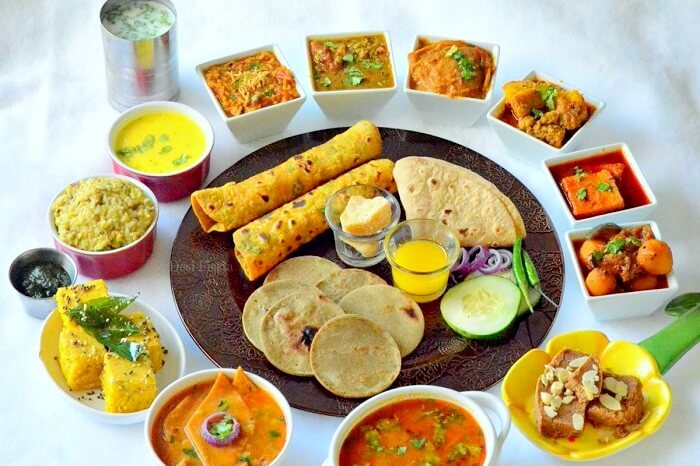
“Ahmedabad ka jaman aur Banaras ka maran” a popular saying in Gujarati which means dining at Ahmedabad and dying at Varanasi, is the way to heaven. One of the thrills of traveling to Gujarat is its multi cuisine. Perhaps the best way to know a state is to cutting to the heart of the extraordinary culture of Gujarat is by exploring its cuisine.
The people of Gujarat have perfected the art of vegetarian cooking and their cuisine is a delectable and mouth watering. To taste the excellent vegetarian Gujarati cuisine, is to have a Thali Meal – the ultimate delightful vegetarian fare.Vishala, a vegetarian restaurant, at Ahmedabad is one of the best choices for tasting vegetarian dishes.
Because of its cosmopolitan mix of people, Ahmedabad is a great place for foodies. Whether you are looking for a Sindhi brunch of dal-pakwan and puri-dal or a Tamil breakfast of idli, upma and dossa, Punjabi parathas or Marwari kachori, a Gujarati thali with its array of vegetarian dishes, fafda and jalebi made in front of you or paya and kaleji fresh off the tawa, the walled city of Ahmedabad has it all.

AND TO TASTE THE BEST AMONG……MANEK CHOWK IS THE DESTINY.
A Gujarati thali typically comprises of one or two steamed or fried snacks called farsans, a green vegetable, a tuber or a gourd shaak (shaaks are main courses with vegetables and spices mixed together into a curry or a spicy dry dish), a kathol (braised pulses like beans, chickpea or dry peas), one or more yogurt dishes like dahi, kadhi (yogurt and pulses soup), raita or sweet shrikhand, rice or khichdi, daal usually toor dal, and sweets like halwas, basundi or shrikhand. Accompaniments include sweet, sour and spicy chutneys, pickles, ghee and a salad of chopped vegetables served raw or may be steamed in spices. Much detailing goes into creating a balance of tastes and textures – you could have coarse, grainy, granular, smooth, uniform, dry and wet dishes on the same platter, the sweetness, bitterness, sourness and heat of each main course would vary between dishes, and the thali has more colours than a rainbow – the yellow of turmeric, the whiteness of dairy products, the redness of tomatos, the green of leafy vegetables, the brown of pulses, and the colours of various spices, relishes and salad vegetables, are harmoniously part of a single thali.
The breads eaten with a thali would include thick and coarse bajra rotla, thin unleavened wheat rotlis, thick and crisp whole wheat flour rotis called bakhris, parathas, savoury griddle bread called the thepla, deep-fried puris, among others. There are many variations like methi thepla or masala puri within these breads. As Gujaratis are globe-trotters, with a large Gujarati Diaspora overseas and around India as well as being great travellers on holiday or pilgrimage around the world, there are many Gujarati farsans, snacks and mini-meals that are designed to travel and keep well – for instance khakras are crisp wafer-like rotis made from wheat, cornflour or lentils that can be carried and eaten with vegetables or accompaniments or dhebras made from a mix of flours can travel better than rotlis.
As in other states of India, Gujarati cuisine is not homogenous through the entire state of Gujarat. While the classic Gujarati thali which is served at most restaurants is the food of central Gujarat with sweeteners like sugar or jaggery added to many dishes even the ones that are fiery hot (it is believed that these sweeteners are used to balance the salinity and hardness of water in cities like Ahmedabad), the cuisine of Saurashtra or the Kathiawad peninsula is strong on garlic, onions and chillies. Some of the key Kathiawadi dishes are sev tamata (dough slivers sprinkled over a spicy tomato puree), lasania bataka (potatoes cooked in a spicy garlic paste), raseela shaak (potatoes and other vegetables cooked in a tomato curry), kadhi – khichdi (yogurt-based curry served with softened rice) and baigan bartha (mashed aubergine), usually eaten with bajra rotla. Dairy products like curds are abundantly used in the cuisine of Kutch and Kathiawad peninsulas, which are arid grassland regions with a large population of livestock, while in the food of Surat and other parts of Southern Gujarat which is one of the wettest regions of Gujarat you will get a bigger variety of green vegetables and tubers like sweet potato in the food.
There are also seasonal specialties – aamraas (mango pool) is commonly served in summer while undhiyu which has roast vegetables and muthias (veg kebabs) is characteristically had in January.
As many of Gujarat’s famous cooks called Maharaj are Brahmins from Mewar and Marwar regions of Rajasthan, their signature dishes like dal-batti-churma and besan gatta have also been incorporated in the thalis served at many restaurants.